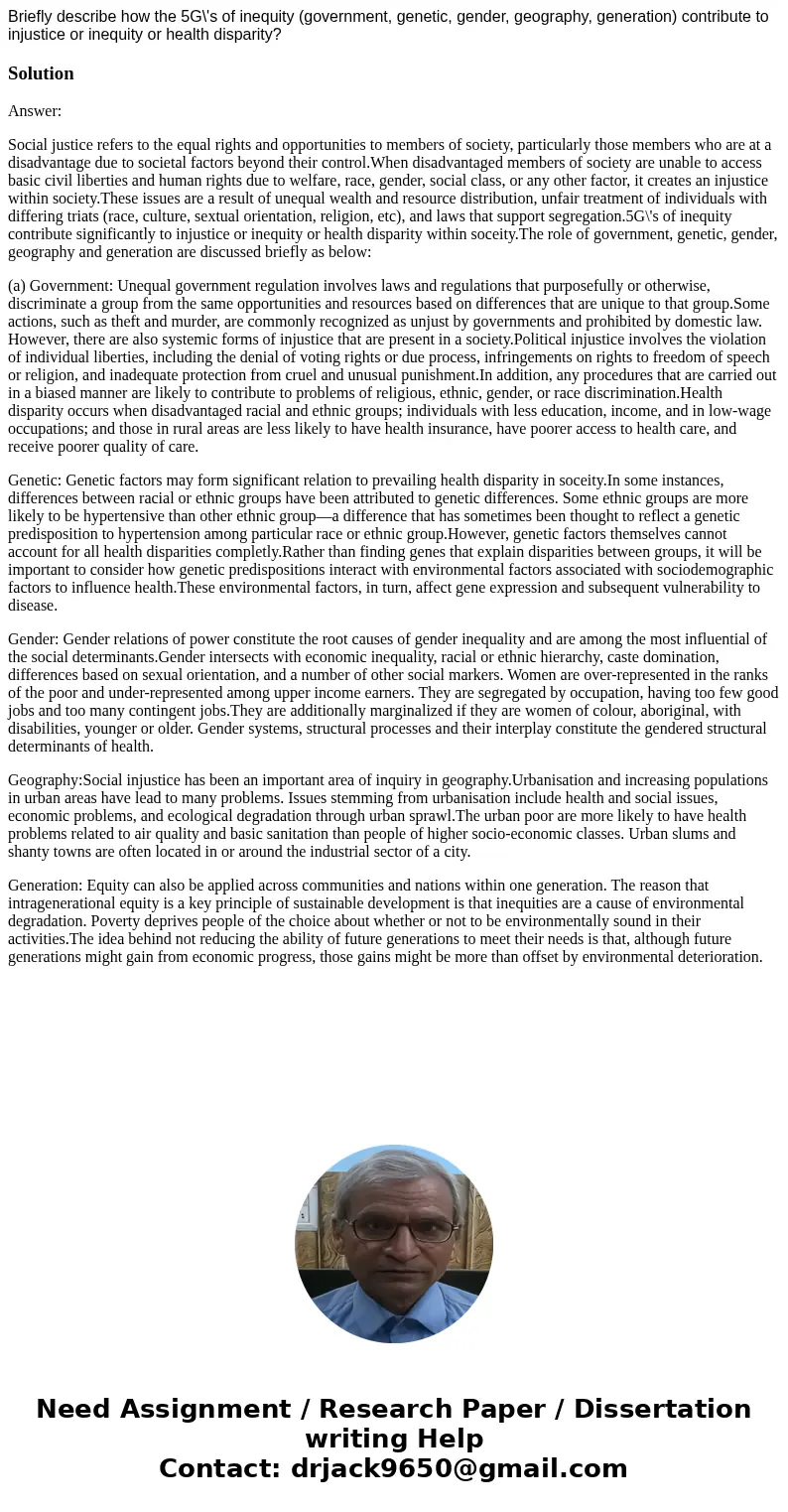Briefly describe how the 5Gs of inequity government genetic
Briefly describe how the 5G\'s of inequity (government, genetic, gender, geography, generation) contribute to injustice or inequity or health disparity?
Solution
Answer:
Social justice refers to the equal rights and opportunities to members of society, particularly those members who are at a disadvantage due to societal factors beyond their control.When disadvantaged members of society are unable to access basic civil liberties and human rights due to welfare, race, gender, social class, or any other factor, it creates an injustice within society.These issues are a result of unequal wealth and resource distribution, unfair treatment of individuals with differing triats (race, culture, sextual orientation, religion, etc), and laws that support segregation.5G\'s of inequity contribute significantly to injustice or inequity or health disparity within soceity.The role of government, genetic, gender, geography and generation are discussed briefly as below:
(a) Government: Unequal government regulation involves laws and regulations that purposefully or otherwise, discriminate a group from the same opportunities and resources based on differences that are unique to that group.Some actions, such as theft and murder, are commonly recognized as unjust by governments and prohibited by domestic law. However, there are also systemic forms of injustice that are present in a society.Political injustice involves the violation of individual liberties, including the denial of voting rights or due process, infringements on rights to freedom of speech or religion, and inadequate protection from cruel and unusual punishment.In addition, any procedures that are carried out in a biased manner are likely to contribute to problems of religious, ethnic, gender, or race discrimination.Health disparity occurs when disadvantaged racial and ethnic groups; individuals with less education, income, and in low-wage occupations; and those in rural areas are less likely to have health insurance, have poorer access to health care, and receive poorer quality of care.
Genetic: Genetic factors may form significant relation to prevailing health disparity in soceity.In some instances, differences between racial or ethnic groups have been attributed to genetic differences. Some ethnic groups are more likely to be hypertensive than other ethnic group—a difference that has sometimes been thought to reflect a genetic predisposition to hypertension among particular race or ethnic group.However, genetic factors themselves cannot account for all health disparities completly.Rather than finding genes that explain disparities between groups, it will be important to consider how genetic predispositions interact with environmental factors associated with sociodemographic factors to influence health.These environmental factors, in turn, affect gene expression and subsequent vulnerability to disease.
Gender: Gender relations of power constitute the root causes of gender inequality and are among the most influential of the social determinants.Gender intersects with economic inequality, racial or ethnic hierarchy, caste domination, differences based on sexual orientation, and a number of other social markers. Women are over-represented in the ranks of the poor and under-represented among upper income earners. They are segregated by occupation, having too few good jobs and too many contingent jobs.They are additionally marginalized if they are women of colour, aboriginal, with disabilities, younger or older. Gender systems, structural processes and their interplay constitute the gendered structural determinants of health.
Geography:Social injustice has been an important area of inquiry in geography.Urbanisation and increasing populations in urban areas have lead to many problems. Issues stemming from urbanisation include health and social issues, economic problems, and ecological degradation through urban sprawl.The urban poor are more likely to have health problems related to air quality and basic sanitation than people of higher socio-economic classes. Urban slums and shanty towns are often located in or around the industrial sector of a city.
Generation: Equity can also be applied across communities and nations within one generation. The reason that intragenerational equity is a key principle of sustainable development is that inequities are a cause of environmental degradation. Poverty deprives people of the choice about whether or not to be environmentally sound in their activities.The idea behind not reducing the ability of future generations to meet their needs is that, although future generations might gain from economic progress, those gains might be more than offset by environmental deterioration.

 Homework Sourse
Homework Sourse